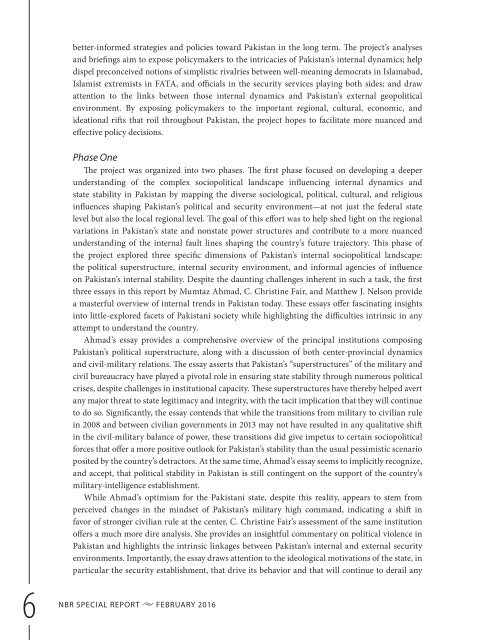pakistan’s
SR55_Mapping_Pakistan_February2016
SR55_Mapping_Pakistan_February2016
You also want an ePaper? Increase the reach of your titles
YUMPU automatically turns print PDFs into web optimized ePapers that Google loves.
etter-informed strategies and policies toward Pakistan in the long term. The project’s analyses<br />
and briefings aim to expose policymakers to the intricacies of Pakistan’s internal dynamics; help<br />
dispel preconceived notions of simplistic rivalries between well-meaning democrats in Islamabad,<br />
Islamist extremists in FATA, and officials in the security services playing both sides; and draw<br />
attention to the links between those internal dynamics and Pakistan’s external geopolitical<br />
environment. By exposing policymakers to the important regional, cultural, economic, and<br />
ideational rits that roil throughout Pakistan, the project hopes to facilitate more nuanced and<br />
effective policy decisions.<br />
Phase One<br />
The project was organized into two phases. The first phase focused on developing a deeper<br />
understanding of the complex sociopolitical landscape influencing internal dynamics and<br />
state stability in Pakistan by mapping the diverse sociological, political, cultural, and religious<br />
influences shaping Pakistan’s political and security environment—at not just the federal state<br />
level but also the local regional level. The goal of this effort was to help shed light on the regional<br />
variations in Pakistan’s state and nonstate power structures and contribute to a more nuanced<br />
understanding of the internal fault lines shaping the country’s future trajectory. This phase of<br />
the project explored three specific dimensions of Pakistan’s internal sociopolitical landscape:<br />
the political superstructure, internal security environment, and informal agencies of influence<br />
on Pakistan’s internal stability. Despite the daunting challenges inherent in such a task, the first<br />
three essays in this report by Mumtaz Ahmad, C. Christine Fair, and Matthew J. Nelson provide<br />
a masterful overview of internal trends in Pakistan today. These essays offer fascinating insights<br />
into little-explored facets of Pakistani society while highlighting the difficulties intrinsic in any<br />
attempt to understand the country.<br />
Ahmad’s essay provides a comprehensive overview of the principal institutions composing<br />
Pakistan’s political superstructure, along with a discussion of both center-provincial dynamics<br />
and civil-military relations. The essay asserts that Pakistan’s “superstructures” of the military and<br />
civil bureaucracy have played a pivotal role in ensuring state stability through numerous political<br />
crises, despite challenges in institutional capacity. These superstructures have thereby helped avert<br />
any major threat to state legitimacy and integrity, with the tacit implication that they will continue<br />
to do so. Significantly, the essay contends that while the transitions from military to civilian rule<br />
in 2008 and between civilian governments in 2013 may not have resulted in any qualitative shit<br />
in the civil-military balance of power, these transitions did give impetus to certain sociopolitical<br />
forces that offer a more positive outlook for Pakistan’s stability than the usual pessimistic scenario<br />
posited by the country’s detractors. At the same time, Ahmad’s essay seems to implicitly recognize,<br />
and accept, that political stability in Pakistan is still contingent on the support of the country’s<br />
military-intelligence establishment.<br />
While Ahmad’s optimism for the Pakistani state, despite this reality, appears to stem from<br />
perceived changes in the mindset of Pakistan’s military high command, indicating a shit in<br />
favor of stronger civilian rule at the center, C. Christine Fair’s assessment of the same institution<br />
offers a much more dire analysis. She provides an insightful commentary on political violence in<br />
Pakistan and highlights the intrinsic linkages between Pakistan’s internal and external security<br />
environments. Importantly, the essay draws attention to the ideological motivations of the state, in<br />
particular the security establishment, that drive its behavior and that will continue to derail any<br />
6<br />
NBR<br />
SPECIAL REPORT u FEBRUARY 2016



